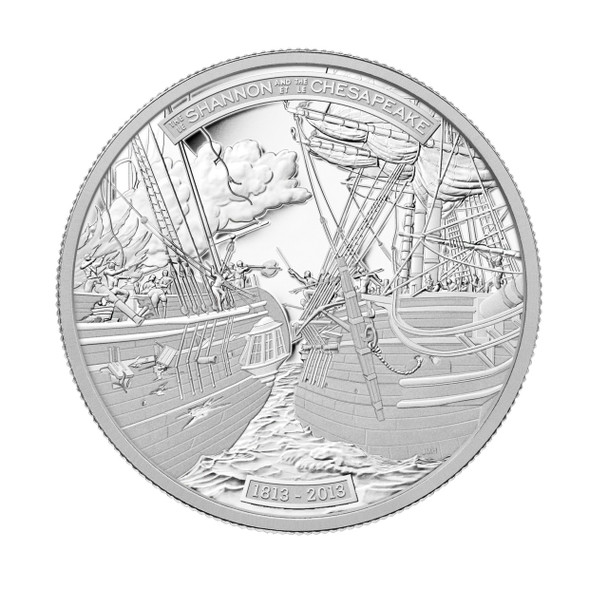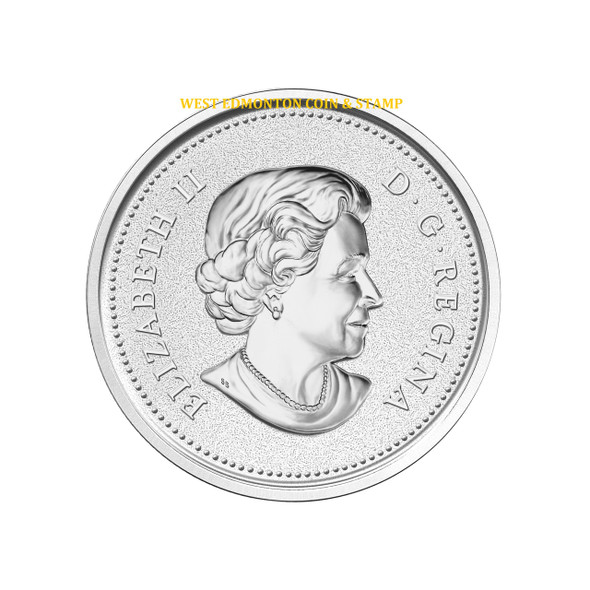Description
Theme:
Victory on the High Seas: HMS Shannon
Description:
Designed by Canadian artist John Horton, the reverse image depicts the final moments of the famous battle of HMS Shannon, pictured on the right, and the battle-worn USS Chesapeake, pictured on the left with its decks ablaze and gun-ports destroyed. The embossed bilingual title celebrates HMS Shannon’s victory by listing its name first: "THE/Le SHANNON AND THE/et le CHESAPEAKE." The reverse side also features the dates "1813 -2013" commemorating the bicentennial of HMS Shannon’s famous defeat of USS Chesapeake. The obverse features the portrait of Her Majesty Queen Elizabeth II by artist Susanna Blunt.
Special Features:
- Limited mintage of 1,500 coins available to coin collectors worldwide, and features highly detailed engraving on a large format coin.
- Created to commemorate the bicentennial of a historic battle of the War of 1812, this unique coin is part of a larger collection celebrating the heroes and events of the War of 1812—a formative event in Canadian history.
- An attractive collectible for numismatists, marine, naval and military enthusiasts, and lovers of Canadian history alike.
- Beautifully detailed reverse design features Canadian artist John Horton’s depiction of HMS Shannon’s historic defeat of USS Chesapeake during the War of 1812.
- Intricate and elegant design is finely engraved and meticulously presented in a beautiful Proof finish (frosted raised elements on mirror background).
Product specifications:
Face Value: 50 dollars
Mintage: 1,500
Composition: 99.99% pure silver
Weight (g): 157.6
Diameter (mm): 65
Edge: Serrated
Finish: Proof
Certificate: Serialized
Artist: John Horton
Advertising Date: May 7, 2013
Launch Date: May 14, 2013
Packaging:
Coin is encapsulated and presented in a Royal Canadian Mint branded maroon clamshell case lined with flock and protected by a black sleeve.
Finished size: 88 mm x 88 mm
Complete Certificate Text:
2012: Bicentennial of the War of 1812
The War of 1812 was a fundamental turning point in Canada’s history: it profoundly influenced British North America’s (Canada’s) sense of identity and united French- and English-speaking inhabitants, Indigenous communities, farmers, soldiers, artisans, and others, in an effort to preserve their ways of life from American invasion.
From the struggle emerged exceptional accounts of some of Canada’s proudest moments. These stories and the heroes that arose from them exemplified the extraordinary characteristics required to defend British North America, and have become important symbols and enduring narratives in the history and evolution of today’s Canada
Victory on the High Seas: HMS Shannon
The Leda-class frigate, HMS Shannon, was launched from Frindsbury, England, in 1806. Captain Philip Broke led his vessel to many victories against the French during the Napoleonic Wars. When tensions between England and America rose in the autumn of 1811, HMS Shannon sailed to North America.
Captain Broke was a highly disciplined leader who rigorously trained his crew for battle. As a result, HMS Shannon was successful in battle against a number of American ships during the war. But at a time when Royal Navy morale was weakening in the face of endless fighting, including five important losses, Captain Broke sought to defeat a large American frigate in order to raise morale and to stop at least one of these large American fighting ships from seizing further victories.
Boston Harbour in June 1813, Captain Broke sent a letter of challenge to Chesapeake’s commander, Captain James Lawrence. In it, Broke challenged Lawrence and Chesapeake’s crew to meet HMS Shannon in ship-to-ship combat. In his letter to Captain Lawrence, Captain Broke taunted him, suggesting that the engagement might “console” his country and its “little navy.” The letter never reached Captain Lawrence, but within hours the two ships were engaged in battle nonetheless. Although the ships were equally matched in size, Shannon’s crew was smaller: 330 men to Chesapeake’s 380. In addition, Captain Broke’s men were tired, provisions were running low, and his ship was showing signs of heavy wear. Nevertheless, Captain Broke’s crew was well-drilled, extensively trained and experienced, while his American opponents were not.
Just before 6:00 p.m. on June 1, 1813, the battle between HMS Shannon and USS Chesapeake began about 40 kilometres (20 nautical miles) east of Boston. The ships opened fire almost simultaneously, but the unassuming Royal Navy frigate Shannon struck first, taking out Chesapeake’s gun-ports: a tactical manoeuvre that had proven successful for Captain Broke in the past.
By 6:15 p.m., Captain Lawrence had been fatally wounded while Captain Broke had suffered a near-fatal head wound. However, the men of HMS Shannon had successfully boarded and captured USS Chesapeake. It proved to be one of the bloodiest single ship battles in any war in the age of sail and had the highest loss of life in frigate engagement during the War of 1812. Altogether, 228 men lost their lives in the intense fifteen-minute fight.
HMS Shannon escorted USS Chesapeake and her defeated crew into Halifax Harbour five days later. Captain Broke had defeated a powerful American frigate, taken it out of commission, and boosted flagging morale in the Royal Navy. Although the stalwart Captain survived his horrific wound, he never fully recovered, and never returned to active duty. He was, however, promoted to the rank of baronet in September 1813.
















